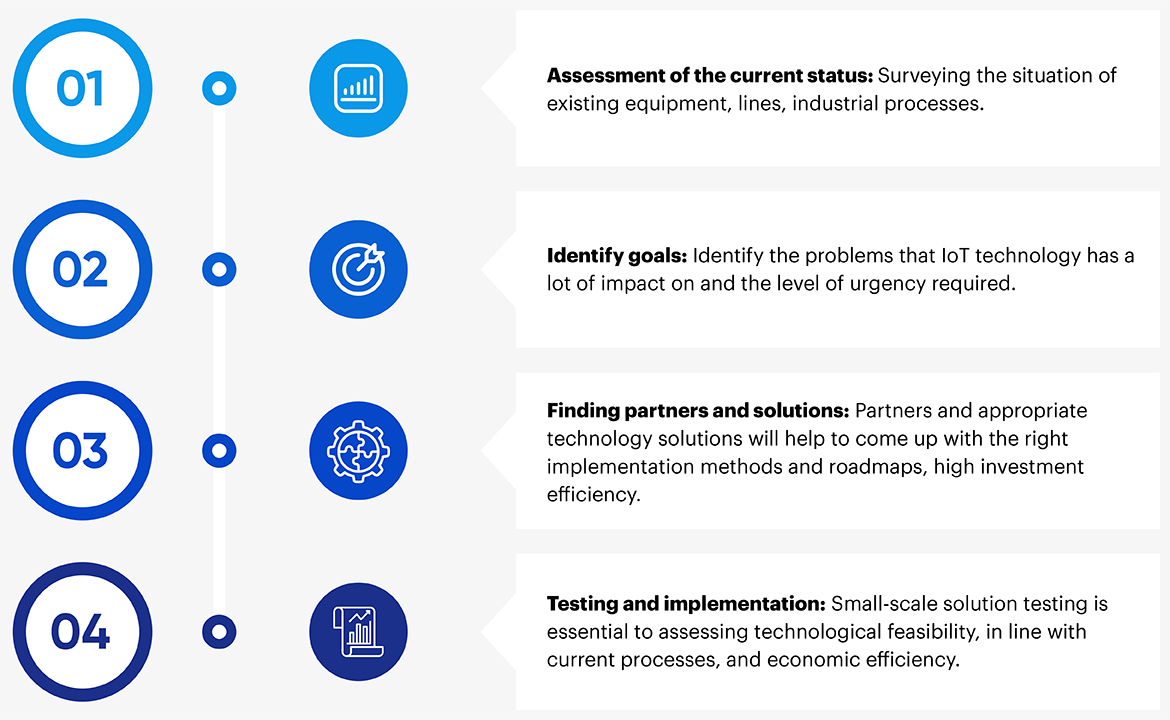According to a report by Research and Markets, the global industrial IoT market size is expected to reach $72.7 billion by 2021 and grow at a CAGR of 9.09%, reaching $112.7 billion by 2026 (1).
Vietnam’s IoT market reached US$2.02 billion in 2019 and is expected to grow at a CAGR of about 24.03% to reach US$7.3 billion by 2025 (2). According to Cisco, more than 50% of Vietnamese companies surveyed recently rated IoT as one of the top three technologies that will impact the digital future of their businesses, and 36% of companies have started using IoT solutions (3).
Industrial IoT Market
Industrial Internet of Things (IIoT) is a collection of sensors, tools and devices connected through the internet to industrial applications, applied in a number of industries such as manufacturing, logistics, oil and gas, transportation, energy, mining and metals, aviation and other industrial sectors. This technology connects multiple devices and combines with other technologies such as cloud computing, data analytics, AI to digitize and improve the productivity of industrial processes, transform business models, while minimizing waste in production and operations. Some large enterprises in Vietnam such as Vinamilk, General Electric,… have applied the latest IIoT technologies to operate automatically to maximize the production stages and optimize the performance of the factory.
Popular IIoT solutions in smart factories
Replacing human activity with connected devices in many manufacturing processes has completely changed the image of manufacturing:
- Remote monitoring and control: IoT devices enable the monitoring of industrial processes and centralized device configurations without the need for people to be present. This solution helps businesses better manage production activities, save operating costs and ensure quality, especially when having to operate many factories in different locations.
- Predict maintenance and optimize machinery and equipment performance: By collecting the data of the active equipment from the sensor (related to temperature, number of rotations, pressure, voltage, etc.), combined with data related to operation history, maintenance history, The plan of operations,… the system can predict operational incidents and schedule maintenance repairs in accordance with the operation plan for technical service teams to fix, minimizing the risk of devices stopping abruptly, as well as optimizing the uptime of equipment.
- Digital twins: The digital twin model of equipment and factories, including design, operation, maintenance data that enables businesses to simulate multiple processes, conduct tests, detect problems and offer remedies without risking or damaging actual assets, as well as supporting production planning, optimizing the operation time of equipment and operating processes.
- Ensuring occupational safety: In hazardous work environments, workers and engineers can equip smart personal devices connected to the control center to measure and detect problems such as monitoring personal health, identifying distances from machines that are not safe enough, detect gas leakage,… can help the factory detect problems faster and respond in a timely manner.
Barriers to IIoT technology application
Although industrial IoT is transforming the future of industries, businesses have a hard time realizing this technology. Here are the common challenges that businesses face during the implementation phase:
- Investment cost: The cost of industrial IoT solutions is quite high. Although one of the main benefits of industrial IoT is improving production efficiency and reducing costs, businesses are unsure of the investment efficiency that the solution actually achieves.
- Connectivity: One of the main requirements for applying industrial IoT is to collect reliable data from devices. However, there are many reasons why it is impossible to collect data from devices such as old-fashion ones and those that do not support data collection or follow different specialized protocols.
- Cybersecurity: Industrial IoT devices also create more security vulnerabilities for businesses. When attacked, in addition to the loss of important data, the devices can be mishandled, suspended production, affecting the reputation and finances of the business.
- Employee Skills: For many businesses, training or finding new staff capable of designing, deploying, and operating modern industrial IoT solutions is a huge challenge.
Strategy to implement IIoT to gradually convert the factory into a smart factory

Assessment of the status quo: Surveying the situation of equipment systems, lines, industrial processes in application as well as the problems of each system that is facing the factory. In Vietnam, in many industries, devices may have a low level of automation, have limited access to data or do not follow popular industry protocols is a common cause of difficulties for businesses when they want to apply IIoT technology.
Identifying objectives: After assessing the current status of the factory, enterprises need to identify the problems that IIoT technology can help solve, prioritize the fields or industrial processes that have a lot of impact on the factory’s production activities. Normally, Vietnamese manufacturing enterprises will need to prioritize basic problems such as data collection and monitoring of factory operations in real time. After having the data, the business can develop other problems such as optimizing operations, predicting maintenance,…

Finding partners and solutions: Based on the problems posed, businesses need to find the right partners and technology solutions to have methods and roadmaps to solve specific problems. In addition to the technology problem, the cost and effectiveness of the solution also need to be evaluated overall.
Testing and implementation: For solutions that have an important impact on the factory’s production operations, testing the solution on a small scale is essential to assessing technological feasibility, in line with current processes, and economic efficiency. After successful testing, enterprises can deploy the solution on a large scale, applied to many different departments.
IIoT technology is an important factor in the digital transformation process for manufacturing enterprises. However, many Vietnamese enterprises in the industrial sector do not have human resources capable of implementing the above steps themselves in a systematic and methodical way. Therefore, businesses need to look for professional, experienced digital transformation consulting partners to develop strategies and roadmaps for implementing appropriate projects, minimizing risks and ensuring their ability to successfully digital transform.
Reference sources:
(1) PR Newswire. 2021 Global Industrial IoT Market Research Report (2021 to 2026) – by Technology, Industry and Region
(2) Research and markets. 2021 Vietnam Internet of Things Market, By Platform
(3) Báo Tuổi trẻ. Phó chủ tịch Cisco: Ứng dụng IoT, doanh nghiệp hãy đi từ vấn đề của mình





